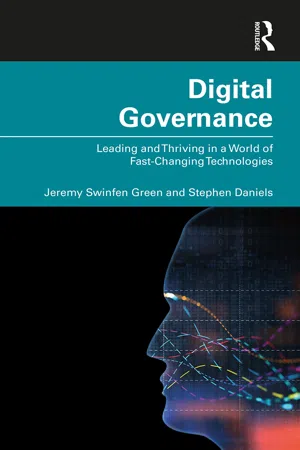
Digital Governance
Leading and Thriving in a World of Fast-Changing Technologies
- 264 pages
- English
- ePUB (mobile friendly)
- Available on iOS & Android
Digital Governance
Leading and Thriving in a World of Fast-Changing Technologies
About this book
Digital Governance provides managers with a simple and jargon-free introduction to the impact that digital technology can have on the governance of their organisations. Digital technology is at the heart of any enterprise today, changing business processes and the way we work. But this technology is often used inefficiently, riskily or inappropriately. Worse perhaps, many organisational leaders fail to grasp the opportunities it offers and thus fail to "transform" their organisations through the use of technology.
This book provides an explanation of the basic issues around the opportunities and risks associated with digital technology. It describes the role that digital technology can play across organisations (and not just behind the locked doors of the IT department), giving boards and top management the insight to develop strategies for investing in and exploiting digital technology as well as arming them with the knowledge required to ask the right questions of specialists and to detect when the answers given are evasive or irrelevant.
International in its scope, this essential book covers the fundamental principles of digital governance such as leadership, capability, accountability for value creation and transparency of reporting, integrity and ethical behaviour.
Frequently asked questions
- Essential is ideal for learners and professionals who enjoy exploring a wide range of subjects. Access the Essential Library with 800,000+ trusted titles and best-sellers across business, personal growth, and the humanities. Includes unlimited reading time and Standard Read Aloud voice.
- Complete: Perfect for advanced learners and researchers needing full, unrestricted access. Unlock 1.4M+ books across hundreds of subjects, including academic and specialized titles. The Complete Plan also includes advanced features like Premium Read Aloud and Research Assistant.
Please note we cannot support devices running on iOS 13 and Android 7 or earlier. Learn more about using the app.
Information
1
Introducing digital governance
Summary
A digital governance manifesto
- Everyone shops online these days. Even if this were true, which it isn’t, 80% of UK retail is still offline (1) and the figure for the USA is nearer 90% (2).
- No one watches TV anymore. UK adults watch 3 hours and 20 minutes of television a day on a TV set (3) and even 18- to 34-year-olds watch over 2 hours a day on average, a third of which is online, e.g. Netflix and BBC iPlayer (4).
- Direct mail doesn’t work anymore. The return on direct mail is still an average of £3.22 for every £1 spent (5).
- You don’t need anti-virus software on an Apple computer. Apple admitted that its devices are not immune from malicious software back in 2012 (6).
- Everyone has a smartphone these days. Not quite: around 20% of people in the UK and 45% of people in Japan don’t own a smartphone (7) and globally the figure is nearer 60% (8).
The scope of digital governance
- Corporate objectives and values. Governance starts with the mission, values and goals of the organisation and how they are achieved. In the case of digital governance, there is a need to understand how the use of existing or eme...
Table of contents
- Cover
- Half-Title
- Title
- Copyright
- Dedication
- Contents
- Author biographies
- 1 Introducing digital governance
- 2 Digital governance strategy
- 3 Managing rapid change in a digital world
- 4 Digitising internal operations
- 5 Transforming products and services
- 6 Digital marketing and sales
- 7 Thinking digital in mergers, acquisitions and venturing
- 8 Digital technology in accounting and financial management
- 9 Human resources in a digital age
- 10 Assuring digital compliance
- 11 Information and cyber security
- 12 Delivering digital privacy
- 13 Think digital resilience
- 14 Emerging digital technologies
- Digital governance glossary
- Index